
Medically Reviewed by Jonathan Pirnazar, M.D. – LASIK Surgeon
Last Updated
Further Reading
- Types of Lenses For Cataract Surgery: Your Guide to IOLs
- Headache Caused By Eye Strain?
- Eye Refraction
- Can Dilated Pupils Be Dangerous?
- Remedies for Eye Bags
- Pearle Vision vs. LensCrafters
- Color Blindness Causes
- Stress & Vision
- 20/40 Vision
- Eczema Around the Eyes
- VR & Your Eyes
- Vision Issues in Pregnancy
- Lupus and Eyes
- Salaries for Optometrists
- Am I a Candidate for LASIK? Take our LASIK Candidate Quiz To Find Out!
- When to Get Cataract Surgery: Symptom Progression & Your Options
- How Long Does LASIK Take?
- The Different Types of Eye Doctor
- Learn & Compare Different Types of Vision Correction Procedures
- Different Types of Eye Care Professionals
- Becoming an Ophthalmologist:
- How Often Should You Get Your Eyes Checked?
- Microblading
- Is Eyebrow Tinting Safe?
- Crow's Feet
- Current State of US Eye Health
- How Do Blind People Experience Their Dreams?
- Childhood Bullying
- Eye Care Guide for Seniors
- Mental Health Effects of Vision Issues
- Vision Care Guide for Veterans
- Career Options for the Visually Impaired
- Driving With Visual Impairments
- Eye Damage From the Sun
- Guide to Bionic Eyes
- How to Test for Your Dominant Eye
- Eye Damage From Solar Eclipses
- Young Adults & Vision Loss
- Optic Nerve Cupping
- Light Sensitivity
- What Is Night Blindness?
- How Eye Patches Affect Your Good Eye
- Blindness From Staring at the Sun
- Types of Vision Tests
- What You Should Know About LATISSE
- Botox Around the Eyes
- Optometrists vs. Ophthalmologists
- Vision Loss & Driving
- Anatomy of the Eye
- Visual Disturbances
- Screen Time & Eyes
- Facts, Stats & Myths - Blue Light
- Jaundice of the Eyes
- Eczema on the Eyelids
- Drugs That Cause Dilated Pupils
- Cholesterol & Your Eyes
- Tea Bags for Eyes
- Eye Disease Statistics
- Brown Eyes vs. Hazel Eyes
- Aqueous & Vitreous Humor
- Prosthetic Eyes
- Guide to Enucleation
- Pros & Cons of Eye Colors
- Contrast Sensitivity Testing
What Is 20/30 Vision? (Is It Bad?)
Home / Vision Education /

Medically Reviewed by Jonathan Pirnazar, M.D. – LASIK Surgeon
Last Updated
A score of 20/20 on a visual acuity test means you can see things at 20 feet that most people can see at 20 feet. A score of 20/30 means you can see things at 20 feet most people can see at 30 feet.
It’s not a full assessment of your vision. But it’s a measure of how well you compare to others in acuity.
If you have 20/30 vision, you will likely be able to see most things quite well even without correction. But some careers require 20/20 visual acuity. And while your acuity might be normal, other issues (such as color blindness) can still impede clear sight.
If your lowered acuity, combined with other eye health issues, keeps you from seeing clearly, your doctor can help. Glasses, contacts, or LASIK could be solutions you discuss with an eye health professional.

What 20/30 Does (and Doesn’t) Mean
A 20/30 visual acuity score means you need to get closer to see things, compared to others with normal 20/20 vision. These people can see an object, such as a road sign, at 30 feet. You will need to get 10 feet closer to see the same thing.
As the American Optometric Association explains, 20/20 vision is not perfect vision. You can have this score and still struggle to see things close to your face. You can also have a 20/20 score and low depth perception, so you can’t discern whether things are tall or short when on a flat surface, like a table.
But a 20/30 score does mean your acuity is slightly subpar, and sometimes, doctors want to monitor the issue. The Cleveland Clinic reports, for example, that children should visit the eye doctor if they have this visual acuity score and they are 5 years old.
Is 20/30 Vision Good?
20/30 vision is often considered a mild deviation from normal 20/20 vision, and it falls within the range of normal visual acuity for most individuals. It means that what a person with normal vision can see at 30 feet, someone with 20/30 vision would need to be 20 feet away to see the same detail.
While 20/30 vision may not be categorized as “bad,” it may indicate a slight reduction in sharpness or clarity compared to 20/20 vision. However, this difference may be negligible in daily life for many people, allowing them to perform most tasks without any significant challenges.
When Is 20/30 Not Enough?
If you have a 20/30 visual acuity score, you might see quite well, much of the time. But there may be times when your vision interferes with your quality of life.
Someone with a score of 20/30 may have the visual acuity to do these things without glasses:
- Get out of bed and walk to the bathroom.
- Drive in familiar neighborhoods.
- Read a book in moderate light.
- Recognize faces in a crowded restaurant.

But as Personnel Today points out, some careers require a visual acuity of close to 20/20. You might need that score if you:
- Drive long distances.
- Fly an airplane.
- Run complex equipment (like nuclear reactors).
- Pilot a ship.
Even with that score, you could struggle in these careers if you also have:
- Color blindness. Pilots and captains must read colorful indicators to steer passengers to safety.
- Depth perception. Seamstresses can’t thread a needle, and technicians can’t solder electronic components without the benefit of 3D vision.
- Color blindness. Pilots and captains must read colorful indicators to steer passengers to safety.
- Depth perception. Seamstresses can’t thread a needle, and technicians can’t solder electronic components without the benefit of 3D vision.
- Peripheral vision. Drivers and pilots need to see hazards coming from all angles, including the sides.
Some people also simply prefer 20/20 vision. They may not need it for work, but they may engage in athletic games that require exceptional acuity. They may participate in motorsports, and they need crisp vision to stay safe. They may just enjoy having the benefit of the sharpest acuity possible.
How Can 20/30 Be Corrected?
Your vision is as unique as your fingerprint, and the solutions you need should be customized. Your health, your lifestyle, your career, and your eye measurements all play a role in determining how an issue should be treated.
Your doctor might choose to address your 20/30 vision with glasses. They are beneficial because they:
- Require no upkeep. You will not need solutions, cleaning cases, and other routine maintenance tools to keep your glasses in tip-top shape.
- Are easily removed. If you struggle with near vision, it might be beneficial to take off your glasses while reading. That is hard to do with contacts.
- Update with your style. New frames can match your outfits and give you an outlet for self-expression.
- Offer some protection. Glasses can shield your eyes during windy days, and that could help if you struggle with dry eyes.
- Can correct other issues. In addition to treating your visual acuity, glasses can amend astigmatism, nearsightedness, and more.
If glasses aren’t right for you, contacts could be helpful. Prepare to pay between $170 and $400 per year without insurance, experts say. And you will have other fees involving cleaning and maintenance. But in return, you will have solid vision correction without anything sitting on your face. For some people, that is the best option out there.

Your doctor may also discuss LASIK. This surgical procedure reshapes your eye, and that allows images to sharpen on the retina. Researchers say it’s common for people to achieve better than 20/20 vision after the surgery, although that is not always the goal.
But as you age, you may need glasses to help you read. LASIK doesn’t protect against age-related eye changes. Even if LASIK successfully corrects your distance vision, you may need reading glasses later in life.
Every one of these solutions comes with both benefits and risks. Some address other issues (like astigmatism). Others do not provide the same benefits. Some are better for people with dry eyes or other medical issues.
Your doctor can help you determine what solution is right for you.
References
- Visual Acuity: What is 20/20 Vision? American Optometric Association.
- Eyesight and Vision in the Workplace. (July 2013). Personnel Today.
- Uncorrected Visual Acuity Better Than 20/20 After LASIK: The Norm Not the Exception. (April 2010). Investigative Ophthalmology and Visual Science.
- How Much Do Contact Lenses Cost? CostHelper.com.
The information provided on this page should not be used in place of information provided by a doctor or specialist. To learn more, read our Privacy Policy and Editorial Policy pages.
Further Reading
- Types of Lenses For Cataract Surgery: Your Guide to IOLs
- Headache Caused By Eye Strain?
- Eye Refraction
- Can Dilated Pupils Be Dangerous?
- Remedies for Eye Bags
- Pearle Vision vs. LensCrafters
- Color Blindness Causes
- Stress & Vision
- 20/40 Vision
- Eczema Around the Eyes
- VR & Your Eyes
- Vision Issues in Pregnancy
- Lupus and Eyes
- Salaries for Optometrists
- Am I a Candidate for LASIK? Take our LASIK Candidate Quiz To Find Out!
- When to Get Cataract Surgery: Symptom Progression & Your Options
- How Long Does LASIK Take?
- The Different Types of Eye Doctor
- Learn & Compare Different Types of Vision Correction Procedures
- Different Types of Eye Care Professionals
- Becoming an Ophthalmologist:
- How Often Should You Get Your Eyes Checked?
- Microblading
- Is Eyebrow Tinting Safe?
- Crow's Feet
- Current State of US Eye Health
- How Do Blind People Experience Their Dreams?
- Childhood Bullying
- Eye Care Guide for Seniors
- Mental Health Effects of Vision Issues
- Vision Care Guide for Veterans
- Career Options for the Visually Impaired
- Driving With Visual Impairments
- Eye Damage From the Sun
- Guide to Bionic Eyes
- How to Test for Your Dominant Eye
- Eye Damage From Solar Eclipses
- Young Adults & Vision Loss
- Optic Nerve Cupping
- Light Sensitivity
- What Is Night Blindness?
- How Eye Patches Affect Your Good Eye
- Blindness From Staring at the Sun
- Types of Vision Tests
- What You Should Know About LATISSE
- Botox Around the Eyes
- Optometrists vs. Ophthalmologists
- Vision Loss & Driving
- Anatomy of the Eye
- Visual Disturbances
- Screen Time & Eyes
- Facts, Stats & Myths - Blue Light
- Jaundice of the Eyes
- Eczema on the Eyelids
- Drugs That Cause Dilated Pupils
- Cholesterol & Your Eyes
- Tea Bags for Eyes
- Eye Disease Statistics
- Brown Eyes vs. Hazel Eyes
- Aqueous & Vitreous Humor
- Prosthetic Eyes
- Guide to Enucleation
- Pros & Cons of Eye Colors
- Contrast Sensitivity Testing